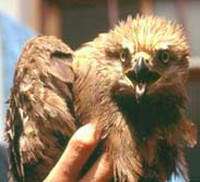A rare bird? Genetic analysis says not so

Efforts aimed at saving one of the world's rarest birds of prey from extinction may be too late, a genetic analysis by researchers at the University of Michigan and The Peregrine Fund suggests.
The last remaining Cape Verde Kites, considered by some to be the rarest raptors in the world, are not Cape Verde Kites at all, but more common Black Kites, the research shows. The real Cape Verde Kites apparently disappeared some time ago and never were a uniquely different species.
The finding, recently published online in the Proceedings of the Royal Society B, adds a new twist to the ongoing debate about how species are defined and how those definitions are used to guide conservation efforts, said David Mindell, a professor of Ecology and Evolutionary Biology and director of the U-M Museum of Zoology.
"It's important to recognize distinctive species as the focus for scarce conservation funds, but as this example shows, there are cases in which species that were recognized over 100 years ago actually aren't valid species," Mindell said. "In such cases, funds might be redirected to species in dire need."
The birds known as Cape Verde Kites live only on the Cape Verde Islands, about 300 miles west of the African country of Senegal in the Atlantic Ocean. Conservationists have been concerned that habitat loss, widespread use of rodent-killing chemicals and other factors were driving those birds to the brink of extinction and threatening other types of wildlife on the islands. In 2002, biologists captured five birds thought to be Cape Verde Kites and considered starting a captive breeding program.
"That's an expensive proposition, so we wanted to take a look at the Cape Verde Kite to get an idea of how distinctive it was genetically—whether it really was something unique that would justify the effort," Mindell said. Working with U-M postdoctoral fellow Jeff Johnson and Richard Watson of The Peregrine Fund, Mindell performed a genetic analysis on material from contemporary Black Kites, Red Kites and historical Cape Verde Kite museum specimens collected between 1897 and 1924 as well as the five kites captured on the Cape Verde Islands in 2002.
"The bottom line," Mindell said, "was that the few kites that are out there now are not Cape Verde Kites; they're Black Kites, which are widely distributed throughout the Old World and are not in danger. Further—and this was even more surprising—the historical specimens of Cape Verde Kites don't even hold together as a distinct group." On the genealogical tree the researchers constructed, the museum specimens originally identified as Cape Verde Kites are not one another's closest relatives; they're scattered within a larger group of Red Kites.
Cape Verde Kites, Red Kites and Black Kites are closely related, medium-sized birds of prey, similar in size to red-tailed hawks. Their plumage is mainly brown and reddish, and their tails are forked. All are opportunistic predators, feeding on insects, small vertebrates and carrion.
The researchers' conclusions don't mean that all conservation efforts in the Cape Verde Islands should be called off. Other species on the islands, such as the Raso Lark and the Cape Verde Warbler, are at risk, Mindell said.
In the long view, Mindell believes studies such as this one bolster the credibility of conservation biologists by showing that the scientists are unbiased and willing to accept results that run counter to expectations.
"We're taking a neutral approach by consistently applying criteria for determining what are distinct evolutionary entities, and the results can go either way," Mindell said. "Sometimes we'll find genetically unique populations that are well-justified for conservation efforts. But we might also find some that were misidentified initially, where people thought that because populations were out on some islands or in unique habitats they were reproductively isolated and genetically distinctive. We're very much in favor of conserving species, habitats and ecosystems; but when it comes to recommendations for particular groups of organisms, we need to carefully assess their status as distinctive species."
The University of Michigan Museum of Zoology collections, housed in the Ruthven Museums Building, include about 15 million specimens, representing mammals, birds, amphibians and reptiles, fishes, mollusks, mites and insects. Researchers study the materials to learn about and analyze biological diversity and to discover the processes and principles of evolution.
Source: University of Michigan

















